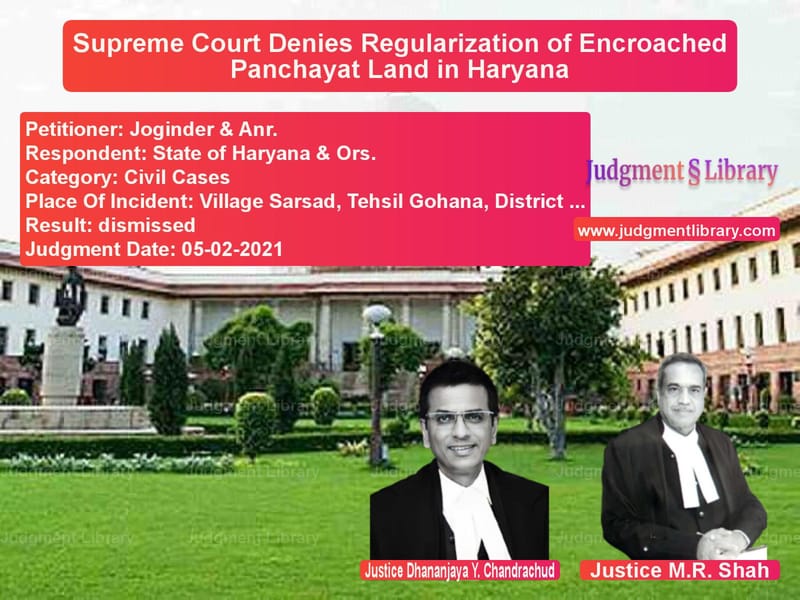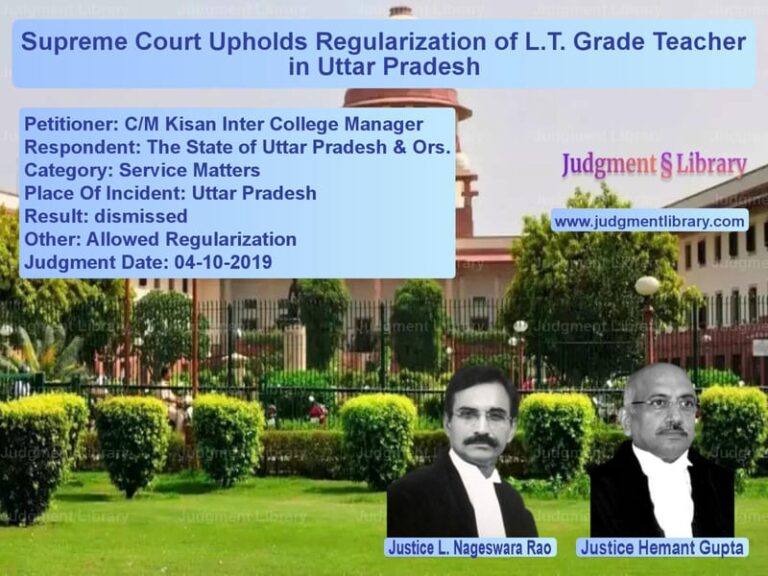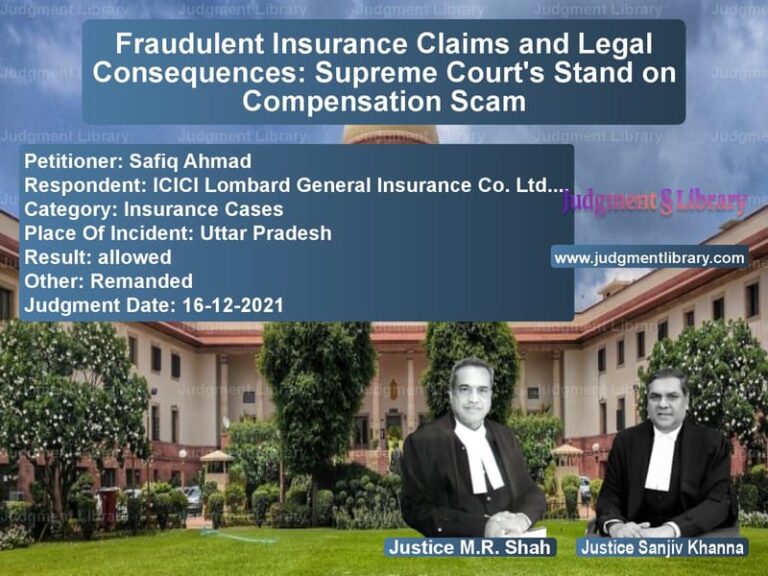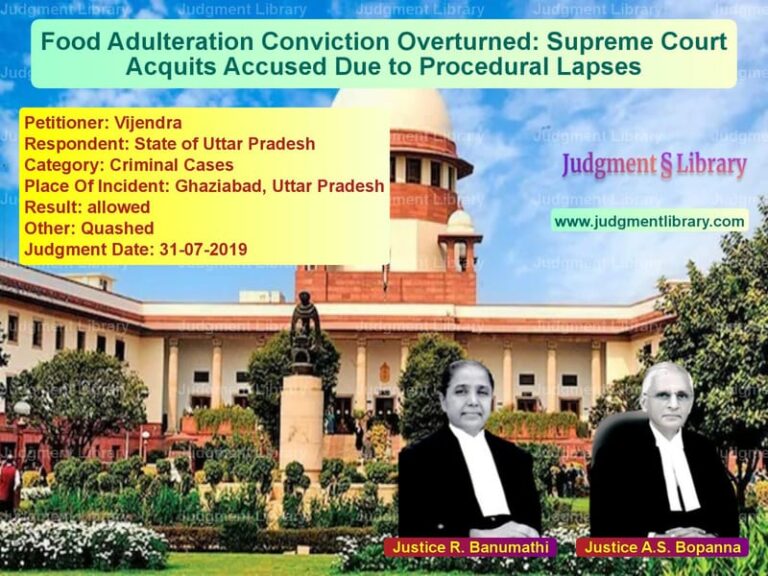Supreme Court Denies Regularization of Encroached Panchayat Land in Haryana
The Supreme Court of India recently delivered a crucial judgment in the case of Joginder & Anr. vs. State of Haryana & Ors., rejecting a plea for the regularization of encroached panchayat land. The ruling reaffirmed that unauthorized occupation of government and village land cannot be legalized, ensuring that such lands remain available for public use.
The case involved two residents of Village Sarsad, Tehsil Gohana, District Sonepat, Haryana, who had illegally constructed houses on panchayat land and sought its regularization under Rule 12(4) of the Punjab Village Common Lands (Regulation) Rules, 1964 (as amended by the Haryana government in 2008). However, their plea was denied by the competent authority, the High Court of Punjab and Haryana, and ultimately the Supreme Court.
Background of the Case
Illegal Occupation of Panchayat Land
The petitioners, Joginder and Karamveer, had encroached upon panchayat land in Village Sarsad and constructed houses without authorization. The land in question was designated as shamlat deh (village common land) and vested in the Gram Panchayat.
Haryana Government’s Policy on Regularization
In 2000, the Government of Haryana framed a policy to allow the sale of panchayat land in unauthorized possession, subject to conditions. Rule 12(4) of the 1964 Rules was amended in 2008, permitting the sale of non-cultivable panchayat land to villagers who had built houses on or before March 31, 2000, provided:
- The occupied land did not obstruct public pathways or traffic.
- The total occupied area did not exceed 200 square yards (including open space).
- The land would be sold at market rate, collector rate, or floor rate—whichever was higher.
Petitioners’ Application and Rejection
Joginder and Karamveer submitted applications to purchase the land they had illegally occupied. The Deputy Commissioner of Sonepat, after conducting an inquiry and physical verification, found that:
- Joginder was illegally occupying 757.37 square yards.
- Karamveer was illegally occupying 239.48 square yards.
Since both exceeded the permissible 200 square yards limit, their applications were rejected. They then approached the Punjab and Haryana High Court, which also dismissed their petition, citing the Supreme Court’s ruling in Jagpal Singh v. State of Punjab (2011), which emphasized that panchayat land must be restored for public use.
Supreme Court’s Observations and Ruling
Interpretation of Rule 12(4)
The Supreme Court, comprising Dr. Dhananjaya Y. Chandrachud and M.R. Shah, analyzed Rule 12(4) and concluded:
“The illegal occupation of panchayat land can be regularized only if the total occupied area, including the constructed and open space, does not exceed 200 square yards.”
The Court rejected the petitioners’ argument that only the built-up area should be considered, stating that the rule applies to the total occupied land.
Regularization is Not a Right
The Court ruled that encroachers cannot claim regularization as a matter of right:
“Persons in illegal occupation of government or panchayat land cannot, as a matter of right, claim regularization. It is subject to policy and compliance with legal conditions.”
The Court emphasized that unauthorized land occupation should be discouraged and not rewarded.
Applicability of the Jagpal Singh Case
Referring to Jagpal Singh v. State of Punjab (2011), the Court reiterated:
“Gram Sabha and panchayat land must be kept for the common use of villagers and not be encroached upon. Such blatant illegalities must not be condoned.”
The Court directed all state governments to prepare schemes for the eviction of illegal occupants and the restoration of panchayat land.
Final Judgment
- The Supreme Court dismissed the appeal and upheld the rejection of the petitioners’ applications.
- The ruling confirmed that encroachments beyond 200 square yards cannot be regularized under Rule 12(4).
- The Court reaffirmed the principle that panchayat land must remain available for community use.
Key Takeaways from the Judgment
- Encroachments on public land cannot be legitimized.
- Rule 12(4) strictly limits regularization to 200 square yards.
- Regularization is a policy decision, not an individual right.
- The Supreme Court has directed all states to evict illegal occupants.
- Panchayat land must be preserved for community use.
Impact of the Judgment
This ruling has significant implications for land governance in India. It reinforces that government and panchayat land must be protected from illegal encroachments. The judgment also prevents a dangerous precedent where encroachers could demand legal ownership of occupied land.
The ruling is expected to strengthen state efforts to reclaim illegally occupied land and prevent future unauthorized occupations. It sends a clear message that public land cannot be seized through illegal means and later regularized.
Conclusion
The Supreme Court’s decision in Joginder & Anr. vs. State of Haryana is a landmark ruling that upholds the sanctity of public land. It prevents encroachers from acquiring legal ownership of illegally occupied panchayat land and reaffirms the principle that such land must remain for public use.
By dismissing the plea for regularization, the Court has reinforced the importance of legal compliance in land use and governance. The ruling is a strong step towards protecting village common lands from unauthorized occupation and ensuring their availability for the benefit of the larger community.
Petitioner Name: Joginder & Anr..Respondent Name: State of Haryana & Ors..Judgment By: Justice Dhananjaya Y. Chandrachud, Justice M.R. Shah.Place Of Incident: Village Sarsad, Tehsil Gohana, District Sonepat, Haryana.Judgment Date: 05-02-2021.
Don’t miss out on the full details! Download the complete judgment in PDF format below and gain valuable insights instantly!
Download Judgment: joginder-&-anr.-vs-state-of-haryana-&-o-supreme-court-of-india-judgment-dated-05-02-2021.pdf
Directly Download Judgment: Directly download this Judgment
See all petitions in Property Disputes
See all petitions in Judgment by Dhananjaya Y Chandrachud
See all petitions in Judgment by Mukeshkumar Rasikbhai Shah
See all petitions in dismissed
See all petitions in supreme court of India judgments February 2021
See all petitions in 2021 judgments
See all posts in Civil Cases Category
See all allowed petitions in Civil Cases Category
See all Dismissed petitions in Civil Cases Category
See all partially allowed petitions in Civil Cases Category







